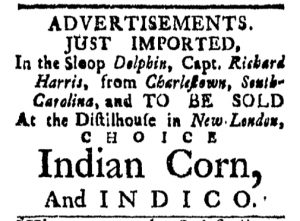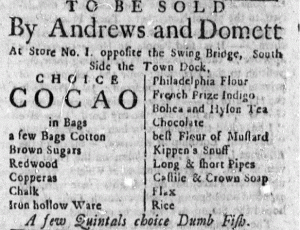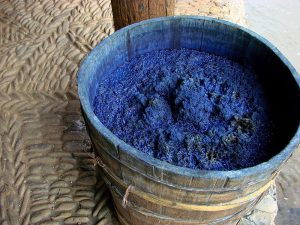GUEST CURATOR: Samantha Surowiec
What was advertised in a colonial American newspaper 250 years ago today?

“JUST IMPORTED … from Charlestown, South Carolina … INDICO.”
Indigo was used as a dye to create vibrant blues and some greens. Although this indigo from Charleston was sold in Connecticut, in an article on South Carolina indigo and its role in the European textile industry R.C. Nash points out that plantation owners preferred to sell their indigo in London rather than in the colonies.[1] During the mid to late eighteenth century, South Carolina indigo made up 25 percent of the product being traded in the Atlantic. The colony first began producing the dye after its rice industry started to fail following the Seven Years War. According to Nash, they quickly gained a foothold in the British market as textile industries in Great Britain grew.[2] Scholars have found that South Carolina indigo was actually of much poorer quality than its competitors from French and Spanish colonies, but it continued to dominate the market because of how cheap it was. As indigo production became more popular, those plantations that produced both rice and indigo began to acquire more and more slaves, eventually coming to own 30 percent more slaves than those that only sold rice or indigo.[3] By producing both rice and indigo, South Carolina plantation owners adapted to and shaped the changing Atlantic trade economy.
**********
ADDITIONAL COMMENTARY: Carl Robert Keyes
With the exception of a short verse in the “Poets Corner” in the first column, advertisements filled the entire final page of the April 21, 1769, edition of the New-London Gazette. Some of those notices marketed commodities, such as “CHOICE Indian Corn, and INDICO,” “SALTS OF LYE,” and “Linseed Oil.” Others offered services, such as “WEBB’S Passage-Boat” that “Continues to ply between New-London and Sterling, as usual.” One offered a reward for the return of an apprentice who ran away from his master. Another reported that twenty-eight hogsheads of rum had been stolen from Nathaniel Shaw’s store and offered a reward for information about the culprits. Several legal notices appeared among these various advertisements, as did an advertisement for a book recently published and for sale by the printer. No classification system aided readers in navigating these advertisements. The compositor arranged them according to where they fit on the page, not by their contents or purpose.
The compositor did not, however, leave readers completely to their own devices. The advertisement for “CHOICE Indian Corn, and INDICO,” immediately below the “Poets Corner” bore the title “ADVERTISEMENTS,” presumably to inform readers that only advertisements appeared throughout the remainder of that issue. Even the placement of that headline did not signal a strict classification system. A paid notice appeared on the previous page. In other issues of the New-London Gazette, the “ADVERTISEMENTS” headline also appeared immediately below “Poets Corner” on the final page, even though numerous advertisements ran on the previous page. Such was the case a week earlier in the April 14 edition; the third featured page half a dozen paid notices before readers encountered the “ADVERTISEMENTS” headline on the fourth page. Advertisements appeared immediately after the shipping news form the customs house, a visual marker just as reliable for indicating the placement of paid notices as the “ADVERTISEMENTS” headline.
The first advertisement in the final column on the last page of the April 21 edition included an additional headline: “NEW ADVERTISEMENT.” All the others on the page, including those underneath it, ran in one or more previous issues. This headline likely aided readers in identifying new content if they skimmed the paid notices quickly. It was the closest the newspaper came to using a classification system for paid notices, though this classification was not based on the contents of advertisements.
**********
[1] R.C. Nash, “South Carolina Indigo, European Textiles, and the British Atlantic Economy in the Eighteenth Century,” Economic History Review 63, no. 2 (May 2010): 386.
[2] Nash, “South Carolina Indigo,” 363-4.
[3] Nash, “South Carolina Indigo,” 379.








